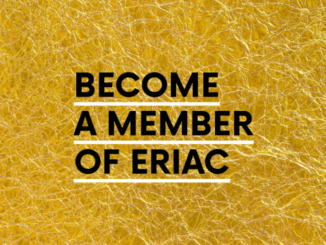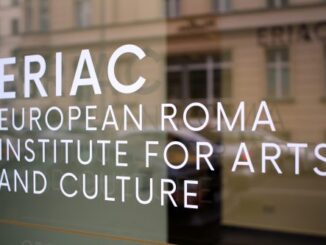Hosted by the European Roma Institute for Arts and Culture (ERIAC) in cooperation with WEAVE (Widen European Access to Cultural Communities Via Europeana) and Council of Europe representation in Venice
11 October 2021
14:00-16:00 CET
ZOOM
FREE REGISTRATION HERE: https://eriac.org/roma-self-representation-in-the-venice…/In this first ERIAC LabDay organized in the framework of WEAVE – Widen European Access to Cultural Communities Via Europeana, a discussion is launched to promote a more permanent exhibition of Roma art and heritage in the context of the prestigious Venice Contemporary Art Biennale. The event takes place at the Council of Europe Office in Venice and online in ZOOM.
In the past there have been various exhibitions of Roma culture and contemporary art in the frame of Venice Biennales, namely in 2007, 2011 and 2019, which represent the greatest efforts ever made by Roma to present Roma art in an international stage in the center of contemporary cultural diplomacy. But in the lack of collecting, archiving and non-existent museum institutions to house artefacts, once these Roma exhibitions are dismantled, their histories become vulnerable and their achievements carry on only as interpersonal – and later transgenerational knowledge, which slowly – with the means of digital remembrance – constitute a new form of intangible cultural heritage. The Roma exhibitions are not connected to the prestigious locations, and known spaces of the Venice Biennale, but to the non-spaces of digital-discussions, oral histories, letter and in-person exchange, archival documents and digital exhibitions.
The “Exhibition” of the largest European minority is considered a “collaborative event”, and not a national pavilion. Roma do not have a national pavilion/building/space, while being the largest national minority to many of the exhibiting national representations. As a consequence, the precarious Roma minority’s presence at the Biennale is possible only if Roma pay the entrance fee as a collaborative event (30,500 Euros) to the Biennale Office, in addition to spending to rent the exhibition space in Venice. In these circumstances, the chance for permanent, tangible representation of Roma in the most prestigious European art event is unimaginable.
The LabDay discussion mitigates the need for a permanent Roma Pavilion as the place to motivate the development of innovative projects and experimental cross-disciplinary work of Roma. In the context of the Venice Biennale, the Roma Pavilion has the potential to become the safe space won by the Roma struggle, a place of intuition, new ideas, discourses, and trends in European contemporary art.
More information: https://weave-culture.eu/labdays/
AGENDA14:00 – 14:10 LABDAY INTRODUCTION
– Dr. Rosa Cisneros, Coordinator of Activity 1 WEAVE, dancer and choreographer, dance historian and critic, Roma scholar, sociologist, flamenco historian.
14:10 – 15:05 PRESENTATIONS of PANELLISTS
– Luisella Pavan-Woolfe, Host, Head of Office, Council of Europe representation in Venice, supporter of ERIAC’s initiatives for cultural inclusion, e.g. FUTUROMA Exhibition in 2019, the 2022 exhibition
– Timea Junghaus, Art historian, contemporary art curator, Executive director of ERIAC, curator of the Roma Exhibition PARADISE LOST at the 52nd Venice Contemporary Art Biennale (2007)
– Prof. Dr. Ethel Brooks, Associate Professor at Rutgers University (U.S), School of Arts and Science, and Chair of Department of Women’s, Gender and Sexuality Studies; Research interests: Visual Cultures, Artistic Practice, Camps and Encampment, Digital Media and Belonging, Nationalism, Post-colonialism and Critical Race Theory
– Daniel Baker, artist of artist of Paradise Lost at the 52nd Venice Biennale (2007) and Call The Witness Exhibition at the 54th Venice Biennale (2011); curator of the FUTUROMA Exhibition at the 58th Venice Biennale (2019); Jury of Roma Exhibition Venice Biennale (2022)
– Miguel Ángel Vargas, Art historian, theatre director, Flamenco researcher, member of Factoría Cultural – Polígono Sur, Institute for Culture and Arts of the Council of Seville and Jury of Roma Exhibition Venice Biennale (2019 and 2022)
– Ilina Schileru, graphic artist, cultural manager and curator of Eugen Raportoru: The Abduction From The Seraglio & Roma Women | Performativity and the Politics of Healing and Listening at the 59th Venice Biennale (2022)
– Eugen Raportoru, painter, visual artist, selected artist of Roma Exhibition at the 59th Venice Biennale (2022)15:05
15:35 DISCUSSION
The discussion will unfold around three topics:
1. Lessons Learned
2. Difficulties of Establishing a Roma Pavilion
3. Solutions and Future Scenarios
15:35 – 15:50 Q&A15:50 – 16:00 FINAL REMARKS
Redaktionen
redaktionen@dikko.nu
Att vara en oberoende tidning kostar pengar så vill du hjälpa oss med att betala vårt fika får du gärna swisha en slant till 123 242 83 40 eller bg: 5534-0046
Vill du annonsera eller sponsra, synas eller höras i våra media?
Kontakta oss på redaktionen@dikko.nu
eller ring 0768 44 51 61
IBAN: SE19 9500 0099 6042 1813 4395
BIC: NDEASESS




